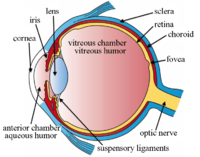
Photo from wikipedia
Environmental droplet keratopathy (EDK), also termed environmental proteinaceous corneal degenerative disease, is a bilateral acquired asymmetric degenerative disease, primarily affecting 40-year-old males, resulting in progressive accumulation of proteinaceous material in… Click to show full abstract
Environmental droplet keratopathy (EDK), also termed environmental proteinaceous corneal degenerative disease, is a bilateral acquired asymmetric degenerative disease, primarily affecting 40-year-old males, resulting in progressive accumulation of proteinaceous material in the subepithelium, Bowman layer, and anterior stroma, and corneal opacification. Since the first published description by Baquis in 1898, the condition has undergone numerous changes in its nomenclature, based upon presumed aetiology, clinical presentation, geographic location and pathology of corneal deposits, patient activities, and eponym, to include Bietti band-shaped nodular dystrophy (named after Italian Ophthalmologist GB Bietti), Labrador keratopathy (named after Labrador, Canada), spheroidal degeneration, chronic actinic keratopathy, oil droplet degeneration, elastoid degeneration, keratinoid corneal degeneration, and most recently, from climatic keratopathy to EDK in 2015. Early and new research share the opinion that the corneal deposition of proteinaceous material in EDK is secondary to a non-mechanical aetiology. More recent research negated a climatic aetiology and confirmed an aetiology of chronic unfavourable exposure to various environmental conditions (Table 1). The newly proposed pathological process in the development of the proteinaceous deposits in EDK favours a decrease in phosphatidylcholine and phosphatidylserine in epithelial cells as a result of lipid peroxidation, the subsequent loss of transmembrane protein function and communication, and increased cytokine and matrix metalloprotinease-9 secretion in the tears and cornea, unmatched by tissue inhibitor metalloproteinase-1 production. Although there has been a lack of correlation between genetic ancestry and mitochondrial DNA in the expression and development of EDK, suspicion still exists, with genetic variances in the 0 Rh+ and DRB1*14 alleles and ALDH3A1 locus being studied. Although several grading systems in EDK have been used over the years (e.g. Freedman, Fraunfelder, Hanna, and Johnson), the majority of clinicians follow a 3-grade classification system, based upon various findings (Table 2). Frequent findings accompanying the conjunctival and/or corneal deposits include pinguecula and pterygium. Other associated findings, notably seen in advanced stages, include neurotrophic keratitis (NK) with its related corneal epithelial thinning and degeneration from impairment in trigeminal nerve innervation, sterile ulceration, bacterial infection and ulceration, perforation, endophthalmitis, and permanent vision loss. Additionally, patients may develop cataract, pseudoexfoliation, and inferior iris depigmentation or atrophy of the anterior layers from inferior iris exposure to UV-B light. Due to the risk of ulceration, perforation, and vision loss, this clinical communication will present a case report and will provide an update on novel treatment and management plans, resulting from the newly proposed environmental aetiology and pathological processes.
Journal Title: Clinical and Experimental Optometry
Year Published: 2022
Link to full text (if available)
Share on Social Media: Sign Up to like & get
recommendations!